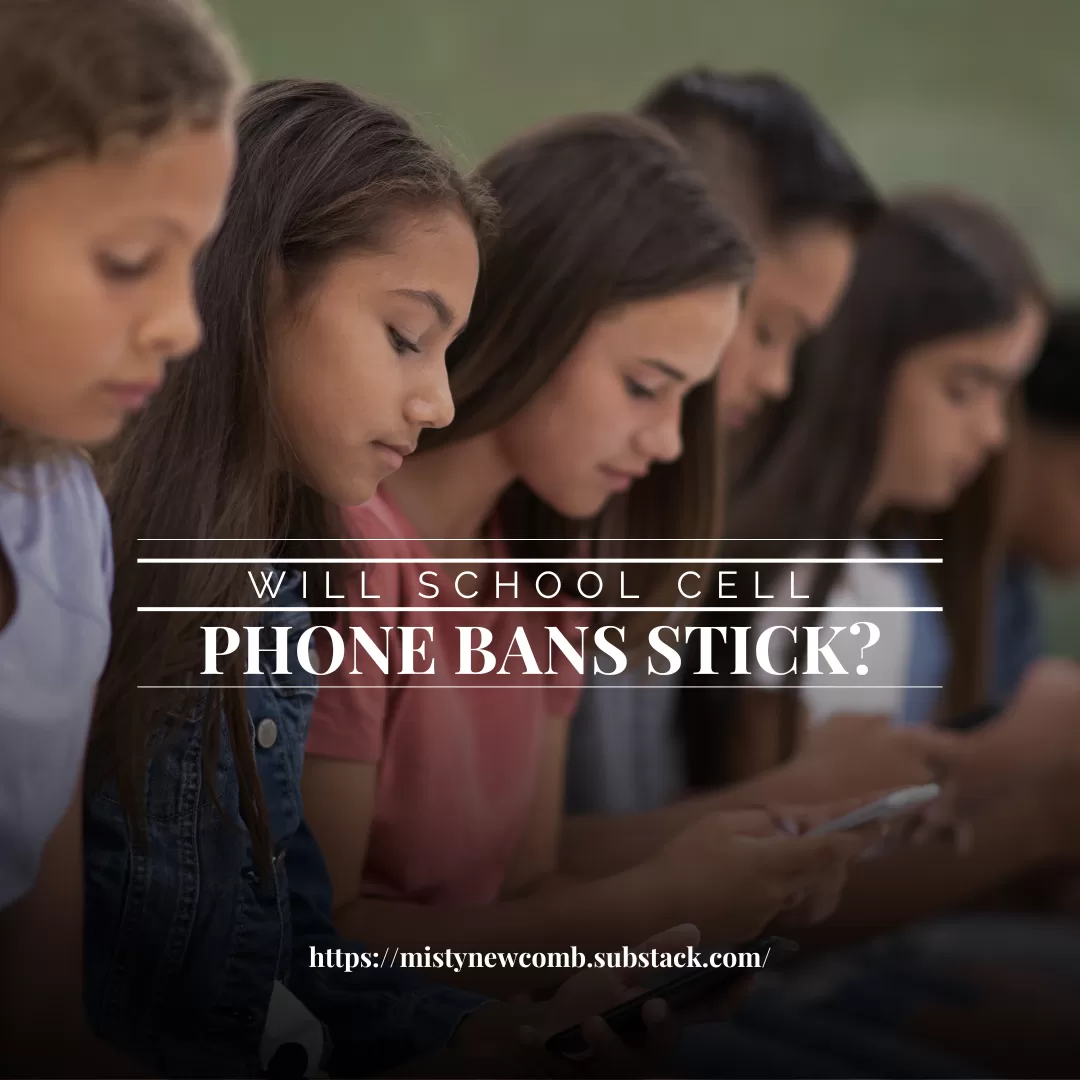“How are you keeping them off their phones?” a man called out gruffly as he walked towards me. From the patch on his shirt, I inferred that Jim was a custodian for the school district hosting the track meet I helped coach that spring day in 2019. “We’ve been watching your students today,” he said as he pointed to a group of men and women wearing the same uniform. “They’ve been talking, laughing, running around here. They’re not even looking at their phones. How are you keeping them off their phones?”
As I oriented myself to the question, Jim lamented the shifting nature of his relationships with the kids at his school. Students used to talk to him in between classes. He and the other custodians felt connected to the life of the school. But things had changed. Students in their district didn’t even make eye contact with people in the hallway. “Their eyes are on their phones, their headphones are in their ear.”
This was a new perspective for me. I hadn’t worked in a school that allowed smartphones since they had become commonplace. Two seemingly unrelated circumstances occurred in 2012: I became the founding Principal of a new Kindergarten-7th grade independent school and smartphone ownership crossed the 50% threshold among American adults.
The following year our student population expanded to 8th grade. Older students began to bring smartphones to school. This immediately created problems. Class time was interrupted by parents coordinating evening plans with their students. Rather than letting lunchtime drama dissipate, students exacerbated issues with texts during afternoon classes. As a mixed-age school, we were concerned that younger students might be exposed to inappropriate content on older students’ phones.
Early in the 2013 school year, we announced a new policy. Students would leave their phones at home or put them in a pouch at the front of the building when they entered in the morning. They never got a chance to become a part of our school culture. Students were allowed to use cell phones at off-campus events like the track meet. They just didn’t that day because they weren’t accustomed to using them around their peers.
Cell Phone Bans Have Unified Policymakers
Our policy wasn’t considered revolutionary or progressive. By most accounts, we were behind the times. Teacher trainings were inundated with the promise of technology. School staff were encouraged to integrate cell phone use into classrooms since all the kids had them.
Several major studies, one Surgeon General Advisory about social media risks for teenagers, and Jonathan Haidt’s book, The Anxious Generation, have shifted the conversation about smartphones and schools. We hit a tipping point after Florida became the first state to ban cell phone use in schools. Several states and large school districts followed.
Almost every week this summer, I read about another school board banning cell phones. Unlike the highly polarizing book bans in 2023, cell phone bans united Republican and Democrat governors. Sarah Huckabee Sanders, Arkansas’ Governor, and Donald Trump surrogate, gave out free copies of The Anxious Generation and funded school cell phone storage pouches. California’s Governor Gavin Newsom–who couldn’t be further from Governor Sanders on most issues–wrote a letter urging schools to enact cell phone restrictions.
How did cell phones–something we all carry in our pocket–become the common enemy that united policymakers?
The Cheerleaders
Advocates of cell phone bans perceive the never-ending stream of notifications as distracting at best. We now know those notifications can even change our capacity to focus. Parents believe school policies already limit these distractions in the classroom. Teachers disagree.
At worst, cell phones facilitate bullying, school fights, depression, and mental health problems by putting the typical teenage angst and social immaturity on steroids.
Growing up, my school had fights, but we couldn’t set up a film crew in advance. School bathrooms have long been a place for sharing secrets and cigarettes, but we didn’t have cell phones equipped with cameras and the mechanism to share the sanctioned and unsanctioned activities that happened there.
Advocates like social psychologist and author Jonathan Haidt say bans are necessary because teen cell phone use represents a collective action problem. Peer pressure will be too great unless everyone gets on board and puts away their phones. None of us can change unless everyone changes.
The Critics
As popular as Dr. Haidt’s book is among policymakers and teachers, he has critics and so do cell phone bans. Most acknowledge that teens have problems today. But some believe the blame has been misplaced on cell phones. In doing so, they fear we won’t address other issues behind the mental health crisis. Others believe cell phones are a problem, but we need to teach students how to properly use them rather than pass draconian bans.
When we instituted a no-cell phone policy at our school, our biggest critics were parents. They wanted to reach their children and coordinate the logistics of their evenings. They couldn’t see the impact of their texts on Ms. Smith’s English class. They had become habituated to instant responses from their friends and family and wanted that same convenience with their kids.
We circumvented this at our small school with humor and a compromise. I poked fun at parents–including myself–for thinking we couldn’t get to 3 pm without talking to our kids. How did our parents ever make it through the school day without talking to us? We also allowed students to check their phones in the school office to coordinate with their parents at lunch. That solution isn’t as effective now that parents have grown accustomed to an unbroken stream of communication with their children.
Parents remain the most oppositional to restrictive phone policies. A survey conducted by the National Parents Union indicates that seventy percent of parents oppose full-on cell phone bans. Some track their child’s location, media use, and even mood and blood sugar levels through smartphone apps.
It’s not just the logistics families want to navigate. Cell phones give parents a sense of security and safety. This is particularly important at school, an institution that has lost the trust of many parents over the last decade.
Fifteen states either issued or incentivized policies banning cell phones in schools at the start of this school year. By mid-September, there had already been two school shootings resulting in the loss of five lives. This is the exact scenario in which seventy-eight percent of parents want their children to have phones with them.
Experts say student cell phone use during a crisis is generally unhelpful and could potentially be harmful. It’s hard to blame parents for wanting that sense of security. But the false sense of control we get from watching our child’s digital footprint may exacerbate a trend toward intensive parenting that hasn’t been particularly beneficial for parents or children.
What is the cost of keeping phones in school?
Schools have had phones in classrooms for a decade. It’s difficult to identify any benefits beyond an illusory comfort for parents. Almost half of Gen Z wishes the social media apps they use had never been created. While certainly not a panacea, outlawing cell phones during the school day could help students limit time spent scrolling, improve focus in class, and restore some social skills that have diminished over the last decade. There is already anecdotal evidence of these benefits where bans have been implemented.
The impetus is on building-level school leaders to pull this off. Teachers can’t add a new power struggle to the list of things they need to accomplish in their 50-minute block of time. Patchwork policies that rely on individual teachers will result in inconsistent enforcement and ultimately failure. Parents will buy into something when they see the benefits for their children. If school leaders take on the challenge of building buy-in, sharing successes, and consistently enforcing policies that promote classroom and social engagement, we could see something special happen in our schools.






Hello there! I know this is kinda off topic but I was wondering which blog platform are you using for this website? I’m getting fed up of WordPress because I’ve had problems with hackers and I’m looking at alternatives for another platform. I would be fantastic if you could point me in the direction of a good platform.
It’s actually a cool and useful piece of information. I am happy that you shared this useful info with us. Please stay us up to date like this. Thanks for sharing.